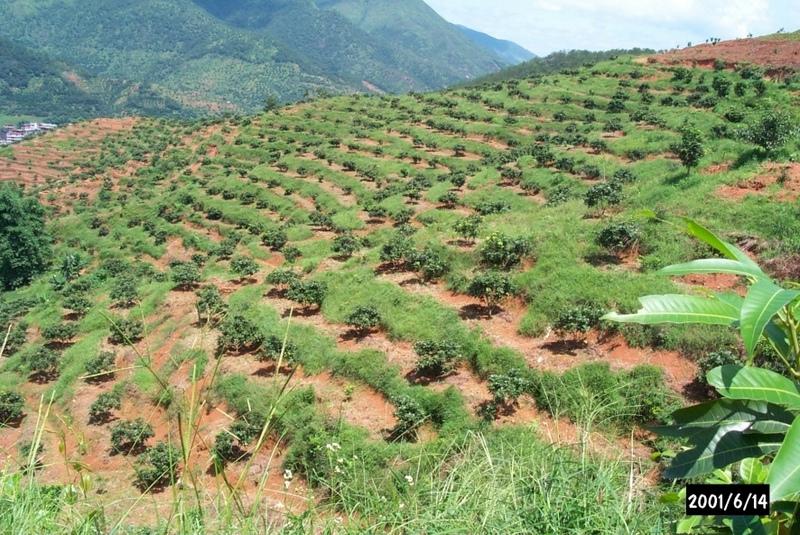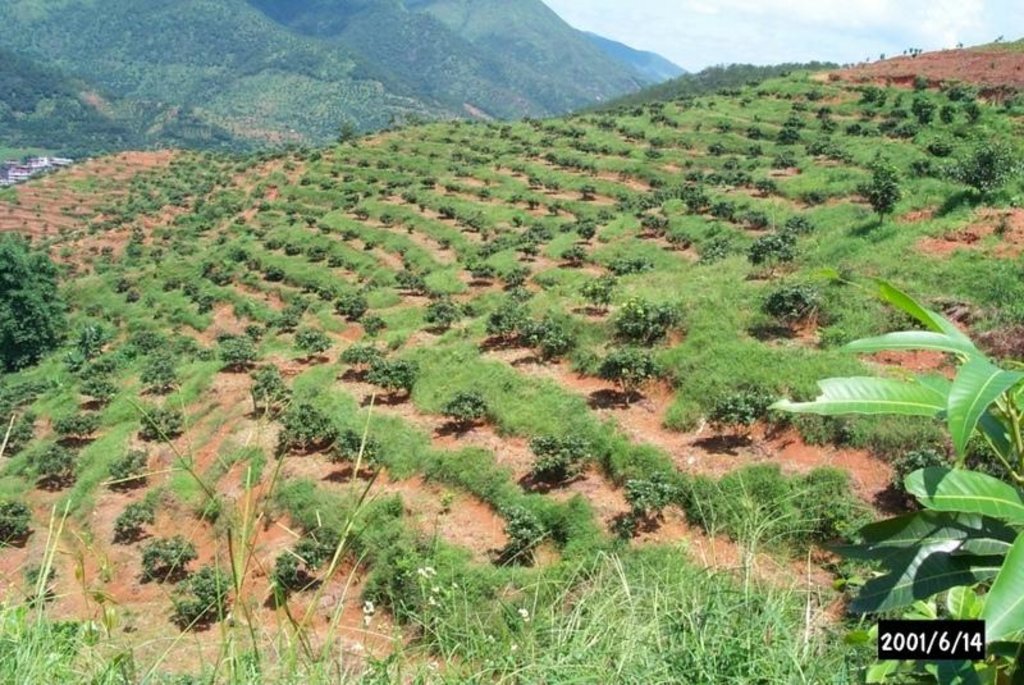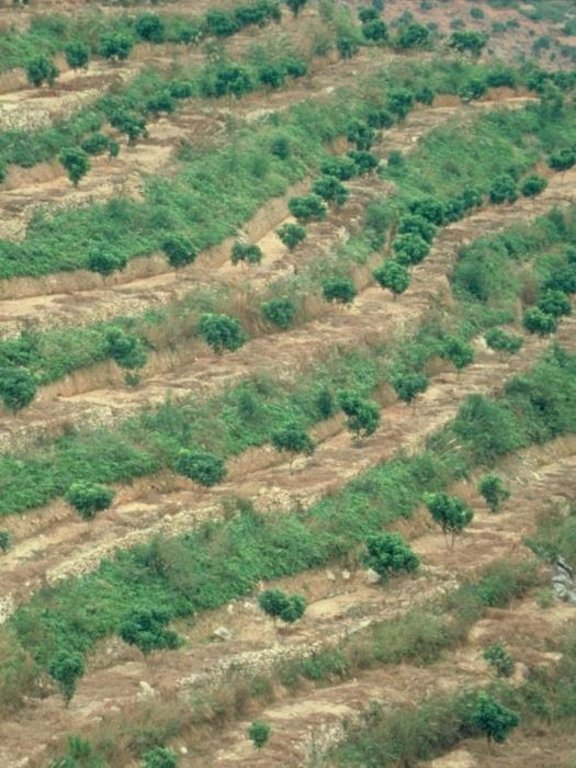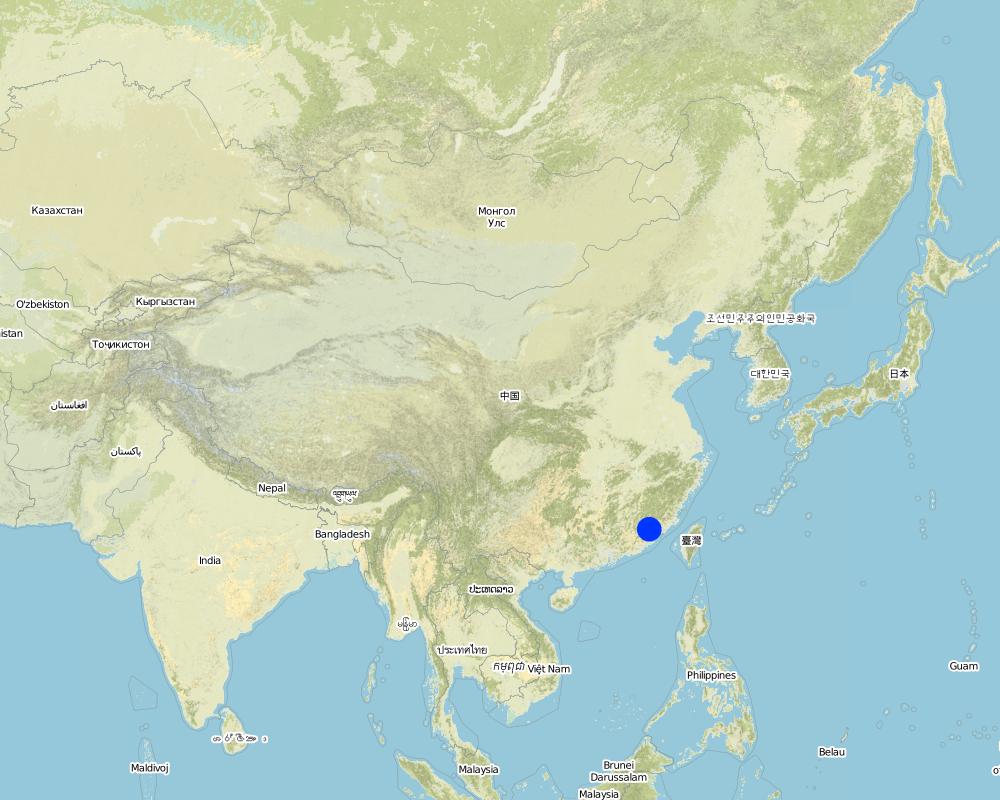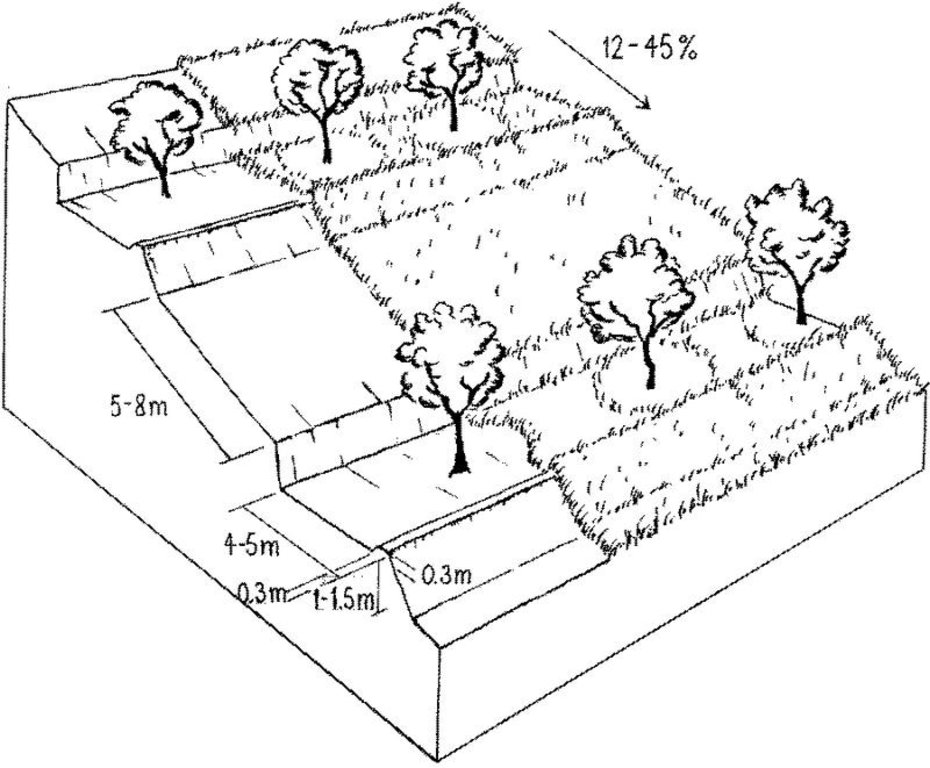Orchard terraces with bahia grass cover [ប្រទេសចិន]
- ការបង្កើត៖
- បច្ចុប្បន្នភាព
- អ្នកចងក្រង៖ Zhanguo Bai
- អ្នកកែសម្រួល៖ –
- អ្នកត្រួតពិនិត្យច្រើនទៀត៖ David Streiff, Deborah Niggli
Bahia grass interplanted in orchard
technologies_1106 - ប្រទេសចិន
ពិនិត្យមើលគ្រប់ផ្នែក
ពង្រីកមើលទាំងអស់ បង្រួមទាំងអស់1. ព័ត៌មានទូទៅ
1.2 ព័ត៌មានលម្អិតពីបុគ្គលសំខាន់ៗ និងស្ថាប័នដែលចូលរួមក្នុងការវាយតម្លៃ និងចងក្រងឯកសារនៃបច្ចេកទេស
បុគ្គលសំខាន់ម្នាក់ (ច្រើននាក់)
អ្នកជំនាញឯកទេស SLM:
Liu Zhengming
Soil Conservation Office of Yongchun County
ប្រទេសចិន
អ្នកជំនាញឯកទេស SLM:
Nie Bijuan
Fujian Soil and Water Conservation Experimental Station
ប្រទេសចិន
អ្នកជំនាញឯកទេស SLM:
Yang Xuezhen
Fujian Soil and Water Conservation Experimental Station
ប្រទេសចិន
អ្នកជំនាញឯកទេស SLM:
ឈ្មោះគម្រោងដែលបានចងក្រងឯកសារ/ វាយតម្លៃលើបច្ចេកទេស (បើទាក់ទង)
Book project: where the land is greener - Case Studies and Analysis of Soil and Water Conservation Initiatives Worldwide (where the land is greener)ឈ្មោះអង្គភាពមួយ (ច្រើន) ដែលបានចងក្រងឯកសារ/ វាយតម្លៃបច្ចេកទេស (បើទាក់ទង)
ISRIC World Soil Information (ISRIC World Soil Information) - ប្រទេសហូឡង់ឈ្មោះអង្គភាពមួយ (ច្រើន) ដែលបានចងក្រងឯកសារ/ វាយតម្លៃបច្ចេកទេស (បើទាក់ទង)
Soil Conservation Office of Yongchun (SCOY) - ប្រទេសចិនឈ្មោះអង្គភាពមួយ (ច្រើន) ដែលបានចងក្រងឯកសារ/ វាយតម្លៃបច្ចេកទេស (បើទាក់ទង)
Fujian Soil and Water Conservation Office (Fujian Soil and Water Conservation Office) - ប្រទេសចិន1.3 លក្ខខណ្ឌទាក់ទងទៅនឹងការប្រើប្រាស់ទិន្នន័យដែលបានចងក្រងតាមរយៈ វ៉ូខេត
តើពេលណាដែលទិន្នន័យបានចងក្រង (នៅទីវាល)?
16/06/2001
អ្នកចងក្រង និង(បុគ្គលសំខាន់ៗ)យល់ព្រមទទួលយកនូវលក្ខខណ្ឌនានាទាក់ទងទៅនឹងការប្រើប្រាស់ទិន្នន័យដែលបានចងក្រងតាមរយៈវ៉ូខេត:
បាទ/ចា៎
2. ការពណ៌នាពីបច្ចេកទេស SLM
2.1 ការពណ៌នាដោយសង្ខេបពីបច្ចេកទេស
និយមន័យបច្ចេកទេស:
Rehabilitation of degraded hillsides through the establishment of fruit trees on slope-separated orchard terraces, with bahia grass planted as protective groundcover.
2.2 ការពណ៌នាលម្អិតពីបច្ចេកទេស
ការពណ៌នា:
In this case study orchards were established between 1991 and 1992 on degraded and unproductive hillsides (wasteland), with slopes of 12-45%. This was achieved by constructing level beds on the contour, mainly as continuous slope-separated orchard terraces, but in some cases as individual planting platforms. Terrace construction was generally undertaken by hand using hoes and shovels.
Purpose of the Technology: A typical terrace has a 4-5 m wide bed and a 1.0-1.5 m high riser. Commonly, a raised earth lip (0.3 m high) is constructed on the terrace edge to retain rainwater. The terrace riser walls are not protected. Even before terrace construction there was little topsoil and in some places the upper subsoil had been lost to erosion. The establishment of fruit trees (lychee, Litchi chinensis and longan, Dimocarpus longan) therefore required deep planting holes (1 m3), filled with organic matter/manure, into which seedlings were planted. In subsequent years additional large quantities of organic matter/manure were applied in circular trenches to the side of the trees, succeeding trenches being gradually further away as the trees grew. Bahia grass (Paspalum notatum) was planted for SWC purposes as a cover crop, to stabilise terrace risers and to improve soil fertility. It has not been used for fodder in this case. The germination rate of bahia grass seeds is comparatively low; therefore instead of direct seeding, nurseries were established to produce seedlings. The bahia grass seedlings were transplanted onto the terrace risers and beds (leaving a space around each fruit tree) and on the hillside slopes between the terraces. The grass grew and spread quickly, restoring a protective vegetative cover following terrace construction.
Natural / human environment: The primary overall purpose of the technology was to rehabilitate degraded hillsides through the planting of economically valuable fruit trees. Terracing reduces soil erosion while retaining most of the rainwater. The application of organic matter creates improved rooting conditions, while restoring and maintaining soil fertility. The bahia grass further provides protective groundcover preventing splash erosion, increasing surface roughness, and thereby slowing down runoff velocity, while contributing to the restoration of the soil’s biological, chemical and physical properties. Irrigation ditches dug along the terraces help to reduce erosion further. This project was planned by SWC specialists: around 6,000 families were allocated orchard plots and provided with seedlings at a subsidised price.
2.3 រូបភាពនៃបច្ចេកទេស
2.5 ប្រទេស/តំបន់/ទីតាំងកន្លែង ដែលបច្ចេកទេសត្រូវបានអនុវត្ត និងបានគ្រប់ដណ្តប់ដោយការវាយតម្លៃនេះ
ប្រទេស:
ប្រទេសចិន
តំបន់/រដ្ឋ/ខេត្ត:
Fujian Province
បញ្ជាក់បន្ថែមពីលក្ខណៈនៃទីតាំង:
Yongchun County
Map
×2.6 កាលបរិច្ឆេទនៃការអនុវត្ត
ប្រសិនបើមិនច្បាស់ឆ្នាំ សូមបញ្ជាក់កាលបរិច្ឆេទដែលប្រហាក់ប្រហែល:
- តិចជាង 10ឆ្នាំមុន (ថ្មី)
2.7 ការណែនាំពីបច្ចេកទេស
សូមបញ្ជាក់តើបច្ចេកទេសត្រូវបានណែនាំឱ្យអនុវត្តដោយរបៀបណា:
- តាមរយៈគម្រោង / អន្តរាគមន៍ពីខាងក្រៅ
មតិយោបល់ (ប្រភេទនៃគម្រោង ។ល។):
The technology comes from the soil conservation theory books and accumulated experiences over years.
3. ចំណាត់ថ្នាក់នៃបច្ចេកទេស SLM
3.1 គោលបំណងចម្បង (១ ឬច្រើន) នៃបច្ចេកទេសនេះ
- កាត់បន្ថយ, បង្ការ, ស្តារឡើងវិញនូវការធ្លាក់ចុះគុណភាពដី
3.2 ប្រភេទដីប្រើប្រាស់មួយប្រភេទ (ច្រើនប្រភេទ) ដែលបានអនុវត្តបច្ចេកទេស

ដីដាំដំណាំ
- ប្រភេទដើមឈើធំៗ និងដើមឈើតូចៗ
ដំណាំចម្បង (ដំណាំកសិ-ឧស្សាហកម្ម និងដំណាំស្បៀង) :
Tree and shrub cropping: lychee, longan

ដីព្រៃ/ដីដាំដើមឈើ
ផលិតផល និងសេវាកម្ម:
- ឈើហ៊ុប
- ផ្លែឈើ និងគ្រាប់ធញ្ញជាតិ
មតិយោបល់:
Major land use problems (compiler’s opinion): Degraded and unproductive hillside slopes (wasteland), with low and declining soil fertility, subject to severe soil erosion
(sheet, rill, gully and mass movement) during periods of heavy and prolonged rainfall.
Major land use problems (land users’ perception): Low fruit yield and little income after consideration of input.
Problems / comments regarding forest use: The farmers\' consciousness of soil conservation are gradually improved and their ability of forest protection are also increased.
Forest products and services: timber, fruits and nuts, nature conservation / protection
Constraints of wasteland (before SWC)
Forest/ woodlands: Also nature conservation / protection
3.3 ព័ត៌មានបន្ថែមអំពីអ្នកប្រើប្រាស់ដី
ការផ្គត់ផ្គង់ទឹកនៅកន្លែងអនុវត្តបច្ចេកទេស:
- ទឹកភ្លៀង និងប្រព័ន្ធស្រោចស្រព
សូមបញ្ជាក់:
Longest growing period in days: 365Longest growing period from month to month: May - Sep
3.4 ក្រុម SLM ដែលបច្ចេកទេសស្ថិតនៅក្នុង
- ធ្វើឱ្យប្រសើរឡើងគម្របដី/ ដំណាំគម្របដី
- hillside stabilizing and restoration
3.5 ការសាយភាយនៃបច្ចេកទេស
បញ្ជាក់ពីការសាយភាយនៃបច្ចេកទេស:
- ត្រូវបានផ្សព្វផ្សាយត្រឹមតំបន់មួយ
ប្រសិនបើបច្ចេកទេសត្រូវបានសាយភាយពាសពេញតំបន់ណាមួយ សូមកំណត់ទំហំផ្ទៃដីអនុវត្តន៍:
- 10-100 គម2
មតិយោបល់:
Total area covered by the SLM Technology is 55 m2.
This is a part of the comprehensive development of Shan Huxi small watershed.
3.6 វិធានការ SLM ដែលបញ្ចូលនូវបច្ចេកទេស

វិធានការក្សេត្រសាស្ត្រ
- A6៖ ផ្សេងៗ

វិធានការរុក្ខជាតិ
- V5: ផ្សេងៗ

វិធានការរចនាស័ម្ពន្ធ
- S1: ការធ្វើដីថ្នាក់ៗតាមជម្រាលភ្នំ
មតិយោបល់:
Main measures: agronomic measures, vegetative measures, structural measures
Secondary measures: management measures
3.7 កំណត់ប្រភេទនៃការធ្លាក់ចុះគុណភាពដីសំខាន់ៗដែលបច្ចេកទេសនេះបានដោះស្រាយ

ការហូរច្រោះដីដោយសារទឹក
- Wt: ការបាត់ដីស្រទាប់លើដោយការហូរច្រោះ
- Wg: ការកកើតឡើងនូវកំទេចកំទីដីស្រទាប់ក្រោម
- Wm: ការបាក់ដី

ការធ្លាក់ចុះសារធាតុគីមីក្នុងដី
- Cn: ការថយចុះជីជាតិ និងកាត់បន្ថយបរិមាណសារធាតុសរីរាង្គ (មិនកើតឡើងដោយការហូរច្រោះទេ)
មតិយោបល់:
Main type of degradation addressed: Wt: loss of topsoil / surface erosion, Wg: gully erosion / gullying, Wm: mass movements / landslides, Cn: fertility decline and reduced organic matter content
Main causes of degradation: deforestation / removal of natural vegetation (incl. forest fires), land tenure (land subdivision)
Secondary causes of degradation: over-exploitation of vegetation for domestic use, other human induced causes (specify) (agricultural causes), poverty / wealth (lack of captial), education, access to knowledge and support services (lack of knowledge)
3.8 ការពារ កាត់បន្ថយ ឬស្តារឡើងវិញនៃការធ្លាក់ចុះគុណភាពដី
បញ្ជាក់ពីគោលដៅរបស់បច្ចេកទេស ដែលផ្តោតទៅការធ្លាក់ចុះគុណភាពដី:
- ការកាត់បន្ថយការធ្លាក់ចុះគុណភាពដី
មតិយោបល់:
Main goals: mitigation / reduction of land degradation
4. បច្ចេកទេសជាក់លាក់ សកម្មភាពអនុវត្ត ធាតុចូល និងថ្លៃដើម
4.1 គំនូសបច្ចេកទេសនៃបច្ចេកទេសនេះ
4.2 លក្ខណៈពិសេសនៃបច្ចេកទេស/ ពណ៌នាពីគំនូរបច្ចេកទេស
Fruit trees on slope-separated terraces with a spacing of 5-8 metres between (dependent on slope). Terrace risers and beds are protected by the fast spreading bahia grass (right): note a grass-free space is maintained around each tree.
Technical knowledge required for field staff / advisors: high
Technical knowledge required for land users: moderate
Main technical functions: control of raindrop splash, reduction of slope angle, improvement of ground cover, increase in organic matter, increase in soil fertility, control of dispersed runoff
Secondary technical functions: increase of surface roughness, increase / maintain water stored in soil, improvement of soil structure
Agronomic measure: organic matter application
Vegetative measure: aligned trees
Vegetative material: T : trees / shrubs
Vegetative measure: dispersed grass
Vegetative material: T : trees / shrubs
Width within rows / strips / blocks (m): 6
Vegetative measure: Vegetative material: T : trees / shrubs
Vegetative measure: Vegetative material: T : trees / shrubs
Fruit trees / shrubs species: longan, lychee
Grass species: bahia
Slope (which determines the spacing indicated above): 16.00%
If the original slope has changed as a result of the Technology, the slope today is (see figure below): 12.00%
Gradient along the rows / strips: 9.00%
Terrace: forward sloping
Height of bunds/banks/others (m): 1-1.5
Width of bunds/banks/others (m): 4-5
Construction material (earth): Using earth for the construction can reduce investment.
Slope (which determines the spacing indicated above): 25%
If the original slope has changed as a result of the Technology, the slope today is: 20%
Lateral gradient along the structure: 6%
For water harvesting: the ratio between the area where the harvested water is applied and the total area from which water is collected is: 1:20
Vegetation is used for stabilisation of structures.
Other type of management: Changing land use patterns - Mountain and hilly areas closure for recover of the forest and grass.
4.3 ព័ត៌មានទូទៅដែលពាក់ព័ន្ធនឹងការគណនាធាតុចូល និងថ្លៃដើម
កំណត់រូបិយប័ណ្ណសម្រាប់ថ្លៃដើម:
- ដុល្លារអាមេរិក
កំណត់ថ្លៃឈ្នួលជាមធ្យមនៃការជួលកម្លាំងពលកម្មក្នុងមួយថ្ងៃ:
3.00
4.4 សកម្មភាពបង្កើត
| សកម្មភាព | ប្រភេទវិធានការ | ពេលវេលា | |
|---|---|---|---|
| 1. | 2.On each terrace one line of fruit trees was established. Deep planting | សារពើរុក្ខជាតិ | winter of 1991 |
| 2. | 2.Fruit tree seedlings were planted. Spacing between trees was | សារពើរុក្ខជាតិ | spring of 1992 |
| 3. | 3.Bahia grass was transplanted onto the terraced hillside | សារពើរុក្ខជាតិ | spring of 1992 |
| 4. | Terraces were constructed by hand.Soil was excavated from the upper portion of the terrace and used to build up the lower portion behind the terrace riser wall to create a level platform (bed). Part of the excavated soil was used to build a terrace lip. | រចនាសម្ព័ន្ធ | winter of 1991 |
| 5. | land preparation for the grass planting | រចនាសម្ព័ន្ធ | winter of 1991 |
| 6. | hill closure | ការគ្រប់គ្រង | Nov. 1999 |
4.5 ថ្លៃដើម និងធាតុចូលដែលត្រូវការសម្រាប់ការបង្កើតបច្ចេកទេស
| បញ្ជាក់ពីធាតុចូល | ឯកតា | បរិមាណ | ថ្លៃដើមក្នុងមួយឯកតា | ថ្លៃធាតុចូលសរុប | % នៃថ្លៃដើមដែលចំណាយដោយអ្នកប្រើប្រាស់ដី | |
|---|---|---|---|---|---|---|
| កម្លាំងពលកម្ម | Voluntary and paid | ha | 1,0 | 840,0 | 840,0 | 100,0 |
| សម្ភារៈដាំដុះ | Bahia transplants | ha | 1,0 | 435,0 | 435,0 | |
| សម្ភារៈដាំដុះ | Fruit tree seedlings | ha | 1,0 | 350,0 | 350,0 | 60,0 |
| ជី និងសារធាតុពុល | fertilizer | ha | 1,0 | 145,0 | 145,0 | 100,0 |
| ជី និងសារធាតុពុល | compost/manure | ha | 1,0 | 70,0 | 70,0 | 100,0 |
| ថ្លៃដើមសរុបក្នុងការបង្កើតបច្ចេកទេស | 1840,0 | |||||
ប្រសិនបើអ្នកប្រើប្រាស់ដីមិនមានថ្លៃដើម 100% សូមបញ្ជាក់ថានរណាដែលចំណាយថ្លៃដើមដែលនៅសល់:
NA
មតិយោបល់:
Duration of establishment phase: 24 month(s)
4.6 សកម្មភាពថែទាំ
| សកម្មភាព | ប្រភេទវិធានការ | ពេលវេលា/ ភាពញឹកញាប់ | |
|---|---|---|---|
| 1. | 2.Digging trenches by the side of the fruit trees and filling with organic | ក្សេត្រសាស្ត្រ | |
| 2. | prune, fertilize, pest control for the fruit trees of Longan and Litchi | សារពើរុក្ខជាតិ | spring, autumn and winter /3 times/year |
| 3. | grass plantation, fertilizaion | សារពើរុក្ខជាតិ | spring and summer /3 times/year |
| 4. | Filling any gaps in the bahia grass. | សារពើរុក្ខជាតិ | |
| 5. | In the first 1–2 years maintenance also involves replacing any fruit tree | សារពើរុក្ខជាតិ | |
| 6. | Weeding around the trees. | សារពើរុក្ខជាតិ | |
| 7. | Repairing terraces damaged by storms. | រចនាសម្ព័ន្ធ | after raining season/4 times/year |
| 8. | regular inspection and management | ការគ្រប់គ្រង | Jan. 1991 / 6 times/year |
4.7 កំណត់ថ្លៃដើមសម្រាប់ការថែទាំ/ សកម្មភាពរបស់បច្ចេកទេស (ក្នុងរយៈពេលមួយឆ្នាំ)
| បញ្ជាក់ពីធាតុចូល | ឯកតា | បរិមាណ | ថ្លៃដើមក្នុងមួយឯកតា | ថ្លៃធាតុចូលសរុប | % នៃថ្លៃដើមដែលចំណាយដោយអ្នកប្រើប្រាស់ដី | |
|---|---|---|---|---|---|---|
| កម្លាំងពលកម្ម | Voluntary and paid | ha | 1,0 | 144,0 | 144,0 | 100,0 |
| សម្ភារៈដាំដុះ | Bahia transplants | ha | 1,0 | 58,0 | 58,0 | 100,0 |
| សម្ភារៈដាំដុះ | Fruit tree seedlings | ha | 1,0 | 36,0 | 36,0 | 100,0 |
| ជី និងសារធាតុពុល | fertilizer | ha | 1,0 | 84,0 | 84,0 | 100,0 |
| ជី និងសារធាតុពុល | biocides | ha | 1,0 | 10,0 | 10,0 | 100,0 |
| ជី និងសារធាតុពុល | compost/manure | ha | 1,0 | 44,0 | 44,0 | 100,0 |
| ថ្លៃដើមសរុបសម្រាប់ការថែទាំដំណាំតាមបច្ចេកទេស | 376,0 | |||||
ប្រសិនបើអ្នកប្រើប្រាស់ដីមិនមានថ្លៃដើម 100% សូមបញ្ជាក់ថានរណាដែលចំណាយថ្លៃដើមដែលនៅសល់:
NA
មតិយោបល់:
Machinery/ tools: hoe, shovel
For establishment: 200 person days for terrace construction, 100 for digging pits and planting trees, 50 for transplanting
bahia grass. For maintenance: 15 person days for terrace maintenance, 40 for digging organic matter trenches, 5 for
bahia grass gap filling. The SWC department produces bahia transplants in nurseries; these are then distributed to the
farmers.
4.8 កត្តាសំខាន់បំផុតដែលមានឥទ្ធិពលដល់ការចំណាយ
ពណ៌នាពីកត្តាប៉ះពាល់ចម្បងៗទៅលើថ្លៃដើម:
steep slope and lots of civil work.
5. លក្ខណៈបរិស្ថានធម្មជាតិ និងមនុស្ស
5.1 អាកាសធាតុ
បរិមាណទឹកភ្លៀងប្រចាំឆ្នាំ
- < 250 មម
- 251-500 មម
- 501-750 មម
- 751-1,000 មម
- 1,001-1,500 មម
- 1,501-2,000 មម
- 2,001-3,000 មម
- 3,001-4,000 មម
- > 4,000 មម
តំបន់កសិអាកាសធាតុ
- សើម
5.2 សណ្ឋានដី
ជម្រាលជាមធ្យម:
- រាបស្មើ (0-2%)
- ជម្រាលតិចតួច (3-5%)
- មធ្យម (6-10%)
- ជម្រាលខ្ពស់បន្តិច (11-15%)
- ទីទួល (16-30%)
- ទីទួលចោត (31-60%)
- ទីទួលចោតខ្លាំង (>60%)
ទម្រង់ដី:
- ខ្ពង់រាប
- កំពូលភ្នំ
- ជម្រាលភ្នំ
- ជម្រាលទួល
- ជម្រាលជើងភ្នំ
- បាតជ្រលងភ្នំ
តំបន់តាមរយៈកម្ពស់ :
- 0-100 ម
- 101-500 ម
- 501-1,000 ម
- 1,001-1,500 ម
- 1,501-2,000 ម
- 2,001-2,500 ម
- 2,501-3,000 ម
- 3,001-4,000 ម
- > 4,000 ម
បញ្ជាក់ថាតើបច្ចេកទេសនេះត្រូវបានអនុវត្តន៍នៅក្នុង:
- មិនពាក់ព័ន្ធទាំងអស់
5.3 ដី
ជម្រៅដីជាមធ្យម:
- រាក់ខ្លាំង (0-20 សម)
- រាក់ (21-50 សម)
- មធ្យម (51-80 សម)
- ជ្រៅ (81-120 សម)
- ជ្រៅខ្លាំង (> 120 សម)
វាយនភាពដី (ស្រទាប់លើ):
- គ្រើម/ មានពន្លឺ (ខ្សាច់)
សារធាតុសរីរាង្គនៅស្រទាប់ដីខាងលើ:
- មធ្យម (1-3%)
- ទាប (<1%)
5.6 លក្ខណៈនៃអ្នកប្រើប្រាស់ដីដែលអនុវត្តបច្ចេកទេស
ទីផ្សារនៃប្រព័ន្ធផលិតកម្ម:
- ពាណិជ្ជកម្ម/ ទីផ្សារ
ចំណូលក្រៅកសិកម្ម:
- 10-50% នៃចំណូល
កម្រិតជីវភាព:
- មធ្យម
- មាន
កម្រិតប្រើប្រាស់គ្រឿងយន្ត:
- ប្រើកម្លាំងពលកម្ម
- ប្រើកម្លាំងសត្វ
សូមបញ្ជាក់ពីលក្ខណៈពាក់ព័ន្ធផ្សេងទៀតអំពីអ្នកប្រើប្រាស់ដី:
Population density: 200-500 persons/km2
Annual population growth: < 0.5%
5% of the land users are very rich and own 10% of the land.
40% of the land users are rich and own 35% of the land.
50% of the land users are average wealthy and own 45% of the land.
5% of the land users are poor and own 10% of the land.
Off-farm income specification: off-farm income is mainly from factory labour
5.7 ទំហំផ្ទៃដីជាមធ្យមនៃដីផ្ទាល់ខ្លួន ឬជួលគេដែលបានអនុវត្តបច្ចេកទេស
- < 0.5 ហិកតា
- 0.5-1 ហិកតា
- 1-2 ហិកតា
- 2-5 ហិកតា
- 5-15 ហិកតា
- 15-50 ហិកតា
- 50-100 ហិកតា
- 100-500 ហិកតា
- 500-1,000 ហិកតា
- 1,000-10,000 ហិកតា
- > 10,000 ហិកតា
5.8 ភាពជាម្ចាស់ដី កម្មសិទ្ធប្រើប្រាស់ដី និងកម្មសិទ្ធប្រើប្រាស់ទឹក
ភាពជាម្ចាស់ដី:
- រដ្ឋ
កម្មសិទ្ធិប្រើប្រាស់ដី:
- កិច្ចសន្យាជួល
6. ផលប៉ះពាល់ និងការសន្និដ្ឋាន
6.1 ផលប៉ះពាល់ក្នុងបរិវេណអនុវត្តបច្ចេកទេសដែលកើតមាន
ផលប៉ះពាល់លើសេដ្ឋកិច្ចសង្គម
ផលិតផល
ផលិតកម្មដំណាំ
ចំណូល និងថ្លៃដើម
ចំណូលក្នុងកសិដ្ឋាន
បន្ទុកការងារ
ផលប៉ះពាល់ទៅលើសេដ្ឋកិច្ចសង្គមផ្សេងៗ
input constraints
មតិយោបល់/ ការបញ្ជាក់:
organic matter/manure
ផលប៉ះពាល់ទៅលើវប្បធម៌សង្គម
ស្ថាប័នសហគមន៍
ស្ថាប័នជាតិ
ការកាត់បន្ថយជម្លោះ
ផលប៉ះពាល់ទៅលើអេកូឡូស៊ី
វដ្តទឹក/លំហូរ
ការប្រមូលស្តុកទុកទឹក
មតិយោបល់/ ការបញ្ជាក់:
rainwater retention
លំហូរទឹកលើផ្ទៃដី
គុណភាពមុន SLM:
70
គុណភាពក្រោយ SLM:
35
ដី
សំណើមដី
គម្របដី
ការបាត់បង់ដី
គុណភាពមុន SLM:
24.3
គុណភាពក្រោយ SLM:
3
សារធាតុសរីរាង្គដី/ការបូនក្រោមដី
ផលប៉ះពាល់ទៅលើអេកូឡូស៊ីផ្សេងៗ
erosion due to raindrop splash
competition between fruit trees and bahia grass
6.2 ផលប៉ះពាល់ក្រៅបរិវេណអនុវត្តបច្ចេកទេសដែលកើតមាន
លំហូរទឹកដែលអាចប្រើប្រាស់បាននៅរដូវប្រាំង
ទឹកជំនន់ខ្សែទឹកខាងក្រោម
កំណកល្បាប់ខ្សែទឹកខាងក្រោម
6.4 ការវិភាគថ្លៃដើម និងអត្ថប្រយោជន៍
តើផលចំណេញ និងថ្លៃដើមត្រូវបានប្រៀបធៀបគ្នាយ៉ាងដូចម្តេច (ទស្សនៈរបស់អ្នកប្រើប្រាស់ដី)?
រយៈពេលខ្លី:
វិជ្ជមានតិចតួច
រយៈពេលវែង:
វិជ្ជមានខ្លាំង
តើផលចំណេញ និងការថែទាំ/ ជួសជុលត្រូវបានប្រៀបធៀបគ្នាយ៉ាងដូចម្តេច (ទស្សនៈរបស់អ្នកប្រើប្រាស់ដី)?
រយៈពេលខ្លី:
វិជ្ជមានតិចតួច
រយៈពេលវែង:
វិជ្ជមានខ្លាំង
6.5 ការទទួលយកបច្ចេកទេស
- ច្រើនជាង 50%
បើអាច សូមបញ្ជាក់ពីបរិមាណ (ចំនួនគ្រួសារ និង/ ឬតំបន់គ្របដណ្តប់):
6593 Households (56 percent of the area)
ក្នុងចំណោមគ្រួសារទាំងអស់ដែលអនុវត្តបច្ចេកទេស តើមានប៉ុន្មានគ្រួសារដែលចង់ធ្វើដោយខ្លួនឯង ដោយមិនទទួលបានសម្ភារៈលើកទឹកចិត្ត/ប្រាក់ឧបត្ថម្ភ?:
- 10-50%
មតិយោបល់:
88% of land user families have adopted the Technology with external material support
5755 land user families have adopted the Technology with external material support
Comments on acceptance with external material support: estimates
12% of land user families have adopted the Technology without any external material support
784 land user families have adopted the Technology without any external material support
Comments on spontaneous adoption: estimates
There is a little trend towards spontaneous adoption of the Technology
Comments on adoption trend: There is a slow spontaneous adoption of the technology, based on the fact that bahia grass is remarkably helpful in controlling soil erosion.
6.7 ភាពខ្លាំង/ គុណសម្បត្តិ/ ឱកាសនៃបច្ចេកទេស
| ភាពខ្លាំង/ គុណសម្បត្តិ/ ឱកាស ទស្សនៈរបស់បុគ្គលសំខាន់ៗ |
|---|
|
An increase in vegetative cover reduces erosion, improves the ecological environment, increases soil fertility and organic matter content, improves How can they be sustained / enhanced? Control weeds and fertilize well. |
|
The combination of structural and vegetative measures has a quick impact on reducing soil erosion and preventing mass movement on hillside slopes How can they be sustained / enhanced? ncrease the vegetative cover and improve soil properties through the addition of plenty of organic matter/manure. |
|
Improved land management practices bringing back degraded wasteland sites into economic production How can they be sustained / enhanced? Demonstration and extension while also improving the enabling legislative environment. |
|
Editors’ comments: In China, large areas of degraded hillsides have been brought back into production by constructing terraces on which fruit trees are planted. In this example the technology has been further improved through planting of bahia grass, as a groundcover, to restore the structure and increase the soil organic matter. On a much smaller scale a case of degraded land conversion is presented from Tajikistan. |
6.8 ភាពខ្សោយ/ គុណវិបត្តិ/ ហានិភ័យនៃបច្ចេកទេស និងវិធីសាស្ត្រដោះស្រាយ
| ភាពខ្សោយ/ គុណវិបត្តិ/ ហានិភ័យ ទស្សនៈរបស់អ្នកចងក្រងឬបុគ្គលសំខាន់ៗ | តើបច្ចេកទេសទាំងនោះបានដោះស្រាយបញ្ហាដូចម្តេច? |
|---|---|
| Orchard development can extend too far up the slope, onto steep mountain sides | Reserve the upper slopes for forest, and restrict orchards to the lower slopes. |
| Potential competition for water and nutrients between the bahia grass | Clean weed (bahia grass included) in the area immediately around the fruit tree. |
| Increase in farm income becomes very positive only after fruit trees start | Consider replacing bahia grass with a more palatable perennial fodder plant to improve farm income in the short term. |
| Low germination rate of bahia seeds | Expand experimental studies (seed treatments, cuttings, taking splits, etc). |
7. ឯកសារយោង និងវេបសាយ
7.2 ឯកសារយោងដែលបានចេញផ្សាយ
ចំណងជើង អ្នកនិពន្ធ ឆ្នាំ ISBN:
Acceptance Materials of Shan Huxi Small Watershed.. 2001.
មានប្រភពមកពីណា? ថ្លៃដើមប៉ុន្មាន?
Soil Conservation Office of Yongchun County
ការតភ្ជាប់ និងម៉ូឌុល
ពង្រីកមើលទាំងអស់ បង្រួមទាំងអស់ការតភ្ជាប់
គ្មានការតភ្ជាប់
ម៉ូឌុល
គ្មានម៉ូឌុល


